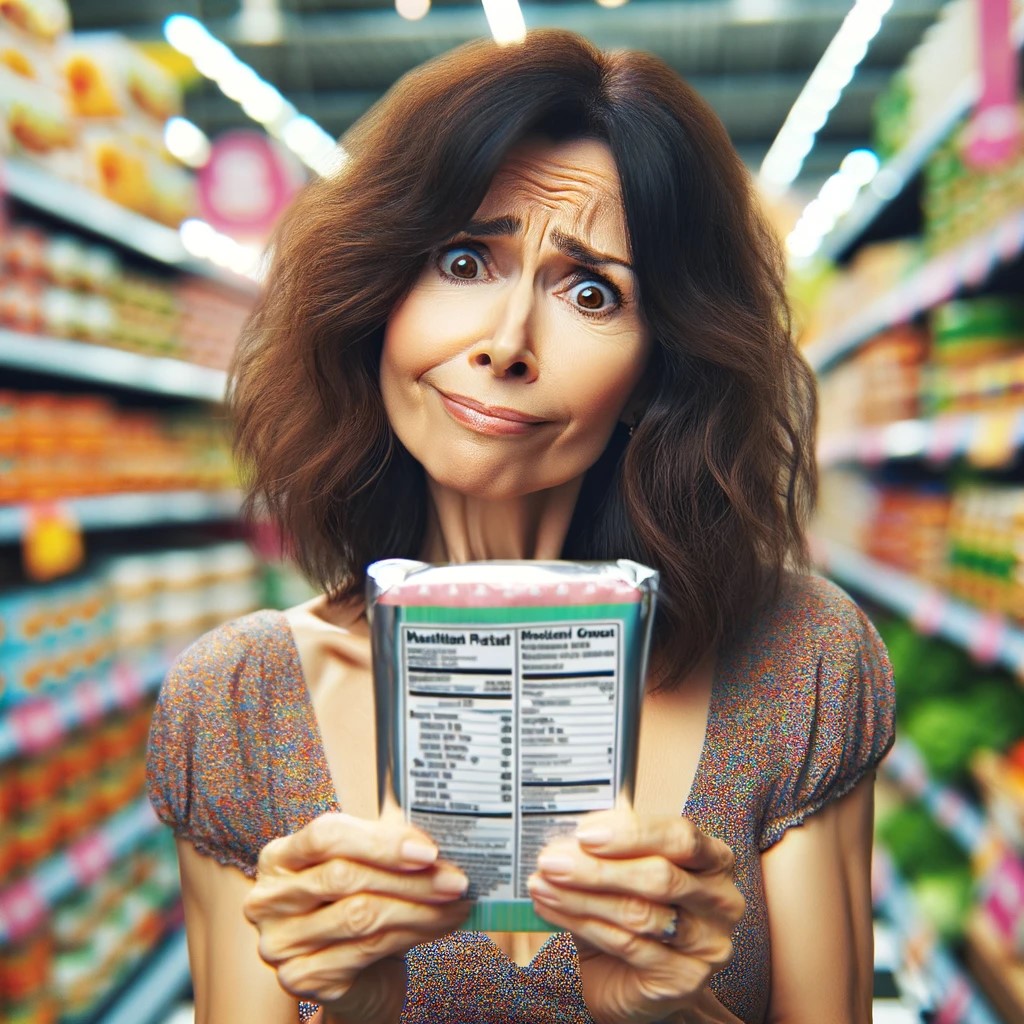

Brooke
Owner of Goodies Gluten Free Bakery.
Navigating the supermarket when you’re following a gluten-free diet due to gluten intolerance or celiac disease can be challenging but manageable with the right knowledge and strategies. Understanding how to read food labels is crucial to avoid gluten and maintain your health. Here’s a comprehensive guide to help you make informed choices at the grocery store.

AT THE STORE:
Hey you’re new at this its give yourself a little extra time!
Especially in the beginning, expect your shopping trips to take longer as you will need to read labels carefully. Understanding what’s in your food is the first step to safe shopping. But don’t worry, becoming a label detective will become second nature with a little practice!
The Perimeter Strategy
An easy way to eat a healthier diet and mitigate a lot of home work is to Plan Your Route. Planning your shopping route around the perimeter of the store where naturally gluten free foods like fresh produce, meats, and dairy are typically located. Many stores also have dedicated gluten-free sections, which can be a safer bet for finding products that meet your dietary needs.
You will get faster, cheaper, and more variety being a label detective gets easier and it’s worth it.
Reading the label can be a drag at first but it can be a real money saver too. Many foods are actually naturally gluten free but they simply haven’t made the effort to clearly label their products. Several grocery stores in recent years have put their best foot forward to help us out too. In my neighborhood we have several health food stores and a few large chain grocers like Safeway and Wal-Mart. Some have a dedicated area for GF items and others are doing additional GF labels to help us easily distinguish safe items.
The Label Decoded
Gluten is a protein found in wheat, barley, rye, and triticale. When reading labels, it’s important to recognize these ingredients and their derivatives, such as malt (derived from barley) and brewer’s yeast (commonly grown on barley). Knowing these ingredients helps in identifying products that might pose a risk.

Know the Culprits:
Knowing exactly what to look for on the label is your first defense. Gluten can appear under many names, including:
- Wheat (e.g., wheatberries, durum, emmer, semolina, spelt, farina, farro, graham, KAMUT® khorasan wheat, and einkorn)
- Rye
- Barley
- Malt (often made from barley)
- Brewer’s yeast
- Wheat starch that has not been specifically processed to remove the presence of gluten to below 20 ppm.
Educate yourself on these terms and remember to check for phrases like “may contain wheat” or “processed in a facility that also processes wheat.”
The Hidden Gluten:
Understanding and identifying risky additives in foods is crucial for those with gluten intolerance or celiac disease, as gluten can be hidden in many food additives. Here’s a deeper look into how to identify such additives that might contain gluten:
Shopping Smart with Additives
- Malt: Often made from barley, malt can appear in various forms such as malt syrup, malt extract, malted milk, malt flavoring, and malt vinegar. All of these are unsafe for individuals on a gluten-free diet.
- Modified Food Starch: This additive is frequently used as a thickener or stabilizer in processed foods. While it can be made from corn, potato, tapioca, or other gluten-free sources, it is sometimes derived from wheat. Products from the EU and US will usually specify “wheat” if it is the source, due to allergen labeling laws.
- Dextrins: Typically used as a thickening agent, dextrins can be made from wheat, and products containing dextrins should be avoided unless they specifically state they are made from corn or another gluten-free source.
- Soy Sauce: Traditional soy sauce is made with wheat. Always check for soy sauces labeled as gluten-free, or opt for tamari or coconut aminos, which is generally made without gluten.
The Ninjas of Gluten Additives
- Hydrolyzed Vegetable Protein (HVP): This is a flavor enhancer made by boiling cereals or legumes, such as soy, corn, or wheat, in hydrochloric acid and then neutralizing the solution with sodium hydroxide. HVP made from wheat will contain gluten. Always verify the source.
- Textured Vegetable Protein (TVP): Often used in vegetarian and vegan diets as a meat substitute, TVP is made from soybeans but can sometimes be mixed with wheat proteins. It’s essential to confirm that TVP is purely from soy.
- Artificial Colorings and Flavorings: These can sometimes contain gluten, although it is rare. Since it is not always clear from the label whether these are derived from wheat, barley, or rye, it is safer to choose products that are certified gluten-free.
- Emulsifiers and Stabilizers: Some emulsifiers and stabilizers might have gluten. While most are gluten-free, it is essential to check the specific types used, especially in creamy and dairy products.
Tips for Avoiding Risky Additives
- Read Labels Thoroughly: The key to avoiding gluten in additives is to read product labels carefully and familiarize yourself with the names of possible gluten-containing ingredients.
- Seek Certification: Look for products certified gluten-free by reputable organizations. These products have been tested and verified to be free from gluten beyond the standard legal requirements.
- Research and Inquire: If you are uncertain about an ingredient or a product, research it online or contact the manufacturer directly to ensure it does not contain gluten.
- Stay Updated: Ingredient formulations can change, so it’s important to continually check labels, even on products that have been safe in the past.
By being vigilant and informed about these additives, individuals with gluten sensitivities or celiac disease can make safer food choices and maintain their health without accidental gluten exposure.
Engage with Online Communities and Apps
Join gluten-free forums, follow blogs, and download apps that are designed to help navigate gluten-free living. These resources can provide up-to-date product recommendations, reviews, and alert you to changes in product formulations.
- Good For You Gluten Free offers a wealth of knowledge for those new to gluten-free living, providing detailed guidance on label reading, nutrition coaching, and a variety of gluten-free recipes (Good For You Gluten Free).
- The Celiac Diva covers a wide range of topics from gluten-free skincare products to various gluten-free foods, making it a great resource for those interested in a comprehensive approach to gluten-free living (The Celiac Diva).
- Gluten Free and More is a blog that not only shares delicious gluten-free recipes but also delves into travel features, medical articles, and more, reflecting a lifestyle approach to managing gluten sensitivity and celiac disease (Gluten Free & More).
- Gluten-Free Goddess, Elana’s Pantry, and Gluten-Free Girl are notable for their personal, relatable content and are particularly praised for their delicious recipes and helpful cooking tips. These blogs are perfect for both beginners and experienced gluten-free cooks looking to expand their culinary repertoire (Kitchen).
Embrace Technology: Your Gluten-Free Shopping Sidekick!
Embrace Technology: Your Gluten-Free Shopping Sidekick!
Shopping gluten-free? There’s an app for that! Let’s dive into the digital world where technology meets dietary needs, turning the daunting task of scrutinizing labels into a fun and speedy scavenger hunt. Here’s how these techy tools are revolutionizing the way we shop for gluten-free goodies:
- Gluten-Free Scanner: Imagine wielding a magic wand that reveals secrets of food products with a simple zap! That’s the Gluten-Free Scanner for you. Use your smartphone to scan barcodes and voilà—immediate gluten-free status with vibrant, color-coded alerts that tell you all you need to know. Although this app has a ton of products, it doesn’t have all so you may not find everything but what is there is quite helpful.
- ShopWell: This app isn’t just smart—it’s like having a dietitian in your pocket! Scan a product and ShopWell tells you if it fits into your gluten-free diet. Discover new favorites and stay on track with dietary goals without breaking a sweat. It’s like having a personal shopper who knows exactly what you need!
- Find Me Gluten Free: This handy app does double duty! Not only does it help you find safe dining spots, product guides, and reviews. Think of it as your trusty gluten-free GPS, steering you clear of gluten landmines and leading you to safe eating havens.
- AllergyEats: Your go-to for navigating the tricky waters of dining out and shopping with allergies. This app crowdsources reviews and ratings, giving you the lowdown on which spots are gluten-free friendly. It’s like having a bunch of friends whispering tips on where to eat and shop!
With these apps, you can transform your gluten-free shopping experience from tedious to terrific, making it quicker, safer, and a whole lot more fun. Ready, set, scan!
Here is a link to look around and find some cool apps for android. And for you Apple users check out this search for GF apple Apps.Al
If you are new to a gluten free lifestyle I hope this helps you feel a bit less anxious. With a little practice and tapping into the support options you’ll be a pro in no time!
Cheers! – Brooke


